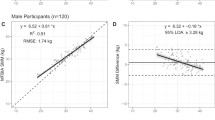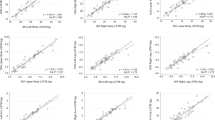Abstract
Background/Objective:
We aimed to develop regression-based prediction equations for estimating total and regional skeletal muscle mass (SMM) from measurements of lean soft tissue mass (LSTM) using dual-energy X-ray absorptiometry (DXA) and investigate the validity of these equations.
Subjects/Methods:
In total, 144 healthy Japanese prepubertal children aged 6–12 years were divided into 2 groups: the model development group (62 boys and 38 girls) and the validation group (26 boys and 18 girls). Contiguous MRI images with a 1-cm slice thickness were obtained from the first cervical vertebra to the ankle joints as reference data. The SMM was calculated from the summation of the digitized cross-sectional areas. Total and regional LSTM was measured using DXA.
Results:
Strong significant correlations were observed between the site-matched SMM (total, arms, trunk and legs) measured by MRI and the LSTM obtained by DXA in the model development group for both boys and girls (R2adj=0.86–0.97, P<0.01, standard error of the estimate (SEE)=0.08–0.44 kg). When these SMM prediction equations were applied to the validation group, the measured total (boys 9.47±2.21 kg; girls 8.18±2.62 kg) and regional SMM were very similar to the predicted values for both boys (total SMM 9.40±2.39 kg) and girls (total SMM 8.17±2.57 kg). The results of the Bland–Altman analysis for the validation group did not indicate any bias for either boys or girls with the exception of the arm region for the girls.
Conclusions:
These results suggest that the DXA-derived prediction equations are precise and accurate for the estimation of total and regional SMM in Japanese prepubertal boys and girls.
This is a preview of subscription content, access via your institution
Access options
Subscribe to this journal
Receive 12 print issues and online access
$259.00 per year
only $21.58 per issue
Buy this article
- Purchase on Springer Link
- Instant access to full article PDF
Prices may be subject to local taxes which are calculated during checkout


Similar content being viewed by others
References
Midorikawa T, Sanada K, Yoshitomi A, Abe T . Is the use of ultrasound-derived prediction equations for adults useful for estimating total and regional skeletal muscle mass in Japanese children? Br J Nutr 2009; 101: 72–78.
Hsu A, Heshka S, Janumala I, Song MY, Horlick M, Krasnow N et al. Larger mass of high-metabolic-rate organs does not explain higher resting energy expenditure in children. Am J Clin Nutr 2003; 77: 1506–1511.
Kim J, Shen W, Gallagher D, Jones A Jr, Wang Z, Wang J et al. Total-body skeletal muscle mass: estimation by dual-energy X-ray absorptiometry in children and adolescents. Am J Clin Nutr 2006; 84: 1014–1020.
Midorikawa T, Ohta M, Hikihara Y, Torii S, Sakamoto S . Prediction and validation of total and regional skeletal muscle volume using B-mode ultrasonography in Japanese prepubertal children. Br J Nutr 2015; 114: 1209–1217.
Abe T, Kondo M, Kawakami Y, Fukunaga T . Prediction equations for body composition of Japanese adults by B-mode ultrasound. Am J Hum Biol 1994; 6: 161–170.
Cole TJ, Bellizzi MC, Flegal KM, Dietz WH . Establishing a standard definition for child overweight and obesity worldwide: international survey. BMJ 2000; 320: 1240–1243.
Tanner JM . Growth At Adolescence. Blackwell Scientific Publications: Oxford, 1960.
Abe T, Kearns CF, Fukunaga T . Sex differences in whole body skeletal muscle mass measured by magnetic resonance imaging and its distribution in young Japanese adults. Br J Sports Med 2003; 37: 436–440.
Snyder WS . Report of The Task Group On Reference Man. Pergamon: Oxford, 1975; 112: 282–285.
Bland JM, Altman DG . Statistical methods for assessing agreement between two methods of clinical measurement. Lancet 1986; 1: 307–310.
Physical Fitness Standards Of Japanese People. Tokyo Metropolitan University: Tokyo, 1989; 22–23: 56–57.
Tothill P, Avenell A, Love J, Reid DM . Comparisons between Hologic, Lunar and Norland dual energy X-ray absorptiometers and other techniques used for whole-body soft tissue measurements. Eur J Clin Nutr 1994; 48: 781–794.
Acknowledgements
We sincerely thank the subjects who participated in this study and their guardians. This study was supported in part by JSPS KAKENHI Grant Number 18800054, 22700623 and 24680069.
Author contributions
TM designed and conducted the research, analysed the data and wrote the paper. MO, YH, ST and SS conducted the research, analysed the data, reviewed and revised the manuscript, and approved the final manuscript as submitted.
Author information
Authors and Affiliations
Corresponding author
Ethics declarations
Competing interests
The authors declare no conflict of interest.
Rights and permissions
About this article
Cite this article
Midorikawa, T., Ohta, M., Hikihara, Y. et al. Predicting skeletal muscle mass from dual-energy X-ray absorptiometry in Japanese prepubertal children. Eur J Clin Nutr 71, 1218–1222 (2017). https://doi.org/10.1038/ejcn.2017.35
Received:
Revised:
Accepted:
Published:
Issue Date:
DOI: https://doi.org/10.1038/ejcn.2017.35
This article is cited by
-
Developmental stage and lower quadriceps flexibilities and decreased gastrocnemius flexibilities are predictive risk factors for developing Osgood–Schlatter disease in adolescent male soccer players
Knee Surgery, Sports Traumatology, Arthroscopy (2023)
-
Growth pattern of lumbar bone mineral content and trunk muscles in adolescent male soccer players
Journal of Bone and Mineral Metabolism (2020)
-
The relationship between organ-tissue body composition and resting energy expenditure in prepubertal children
European Journal of Clinical Nutrition (2019)
-
Fat-Free Adipose Tissue Mass: Impact on Peak Oxygen Uptake (VO2peak) in Adolescents with and without Obesity
Sports Medicine (2019)



